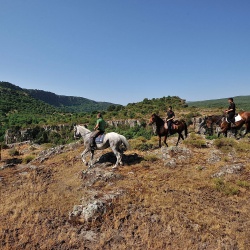

VIVA - New Active Tourism Itineraries in Villanova
Main sections of the site and Thematic sites
Main navigation

Church of Santa Maria degli Angeli - Padria
Address: Piazza Convento, 07015 Padria (SS)
The Church of Santa Maria degli Angeli, also known as Church of Sant’Antonio, is linked to a former convent of Franciscan Friars on the northern and western sides. Due to the lack of documented evidence, we can only make assumptions regarding the precise chronology of the church and its relation with the construction of the convent. The convent was probably built during the seventeenth century by order of Isabella, wife of the Count of Sedilo Jerome Cervellón and daughter of Pietro Onofrio, Feudal Lord of the Incontrada of Bonvehì. The building was constructed on a plot of land thanks to the donations provided by Isabella. Some documents reveal that the convent was probably built not far from a church dedicated to the Virgin of Itria, but the analysis of the arrangement of the building and of the wall parameters lead to the hypothesis that the convent was build around an existing church, which was included later.
The present Church of Santa Maria degli Angeli adopts the ground-plan characterised by a longitudinal aisle with side niches enclosed in the thickness of the wall. The presbytery is characterised by a quadrangular plan. A series of wooden or marble altars fill the free spaces of the aisle. A marble balustrade divides the space of the presbytery, slightly raised, which also houses a fine marble altar. On the counter façade, above the entrance portal, there is a stand which is accessible via an outside staircase, but in ancient times it had direct access from the Convent through a narrow hallway with staircase. The church is barrel-vaulted with intrados that divide the space.
The façade is sectioned by corner pilasters that enclose the space and by horizontal cornices that divide the façade in three sections. The lower section presents the entrance portal, enhanced by the architrave and piers made of limestone. In line with the entrance portal, and below a large window, is the emblem of the Franciscan Friars which depicts two arms crossed, one wearing the habit and the other naked, both presenting stigmata.





